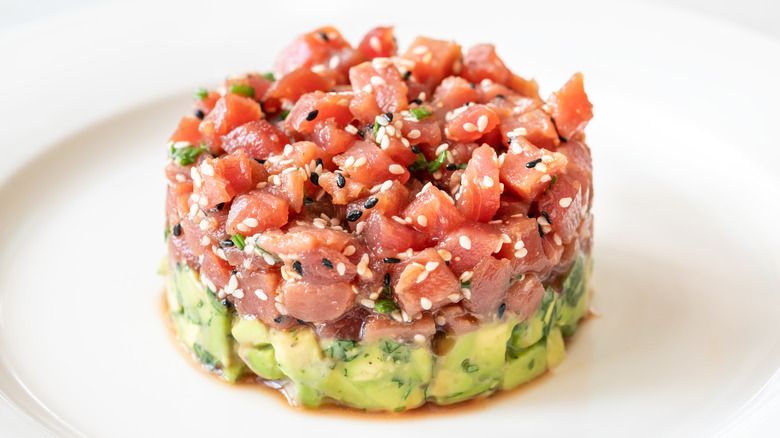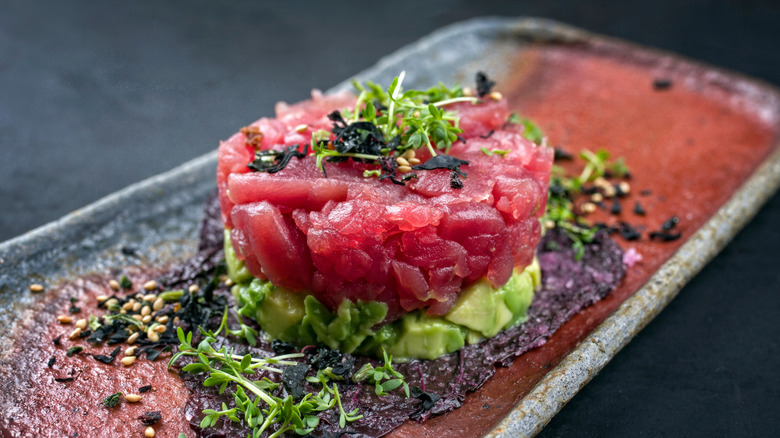How Long Is Leftover Tuna Tartare Safe To Eat?
Beef tartare is known for its rich and meaty taste and texture. However, if you're looking to switch things up and experience the flavors of the sea, then you may want to consider making tuna tartare (or why not both for some surf and turf). The dish was invented by Japanese chef Shigefumi Tachibe in 1984. Like its land cousin, tuna tartare features raw meat, in this case tuna. The dish is made with sushi-grade tuna and avocado, chopped up and combined with various sauces and seasonings such as chile, ginger soy, and lime juice. The dish is perfect for those who love their sushi without all that rice and seaweed wrapping.
However, tuna tartare can be tricky to fix (which we'll get to below) and even trickier to store. If you have a bit of tuna tartare, you may be wondering if you can keep the dish for later or if should you chunk it immediately. Fortunately for those who get full easily or plan to make the dish and eat it later, tuna tartare does keep for a short time. According to USDA, raw tuna will last one to two days if properly stored. So you have a day or two to eat any leftovers.
How to store tuna tartare
According to USDA, you should keep any raw tuna in the refrigerator unless you plan on cooking it. So no, your tuna tartare will go bad if left out on your counter, which the Centers for Disease Control and Prevention strongly discourages for food safety. When storing your tuna tartare in the fridge, consider keeping your marinated tuna away from other ingredients you might use like avocado. This is due to quality purposes as your dish will taste better by mixing the avocado and fish right before consumption. Otherwise, your avocado might run together with your tuna, ruining the texture.
However, if you want your tuna tartare to last for an extended period of time, then your best bet is to freeze it. According to USDA, frozen fish will last indefinitely from a safety perspective but should be consumed within eight months from a quality perspective. Likewise, you can also freeze avocado as well, meaning you don't have to worry about not having the creaminess for your tartare. However, from a quality perspective, avocados have a shorter shelf life when frozen and should be used within a month for best results. It's better to use frozen fish.
How to safely eat tuna tartare
If you're concerned that freezing your tuna may affect the texture of your tuna tartare, then you should know that it's better to use frozen fish to reduce your risk of any foodborne illnesses. According to the FDA, you should consider freezing your tuna to kill any parasites that your fish may have. Healthline reports that you should freeze your tuna at -4 degrees Fahrenheit for seven days or at -31 degrees Fahrenheit or lower for at least 15 hours.
So, your defrosted tartare should still be good from a quality perspective. If you're worried about freezing fish that has already once been frozen, then keep it in mind that it's perfectly fine to do so. However, your fish may be slightly drier due to the lost moisture during the thawing process. Besides using frozen tuna to reduce your risk of getting sick, you should also use quality fish as well. This means you probably want to skip using any tuna bought from the grocery store due to its longer shipping processes. Instead, you will want to find a local fish market and buy sushi-grade tuna. Look for any worrisome signs like off-color or smell. You could also try making tartare with one of these fish.


